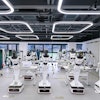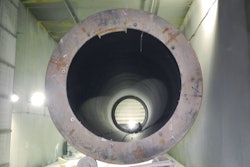With a total weight of two million pounds, and blades as long as 400 feet, a single 15 mega-watt wind turbine would be able to power nearly 3,900 homes. Unfortunately, they don’t exist … yet.
“Wind energy is becoming very close to reaching price parity with fossil fuels,” explains Brian MacCleery, principal product manager for clean energy technology at National Instruments (NI). “The industry is moving toward larger and larger wind turbines because the cost-per-watt goes down as the size of the turbine goes up.”
To prepare for these turbines, a team of engineers at Clemson University, in conjunction with various partners (including National Instruments) have come together at the world’s most advanced wind-turbine testing facility at the Clemson University Restoration Institute (CURI).
View: Photos of the Day: 15 MW Test Rig Drive Unit Weighs 400 Tons
The multi-million dollar facility, formally a warehouse for U.S. Navy non-hazardous materials, is currently under construction. When finished, it will be capable of full-scale accelerated mechanical and electrical testing of advanced wind turbine drivetrain systems.
"This facility is unique because it has the ability to simulate and test the entire cyber-physical system, including the electromechanical machine of the wind turbine, the dynamics of the power grid, and the cyber control system software algorithms, and how they interact," says Curtiss Fox, Duke Energy e-GRID director, Clemson University Restoration Institute.
Combining a 15 MW test rig drive unit, and a 15 MW hardware-in-the-loops simulator, the facility is designed to test wind turbine nacelles (generating component enclosures) that are three times larger than any currently being used today. Before time and money are invested into the world’s largest wind turbine, the nacelles first undergo rigorous testing.
“[The wind turbines] are very expensive to fix 100 meters up in the air,” adds Fox. “If you have any plans of going offshore with it, you no longer have a stable crane base. Things get even more difficult and more expensive out there. The reliability of the mechanical components needs to be [addressed].”
15 Million Watts
Forty-three feet in diameter, the 15 MW test rig drive unit weighs 400 tons, with a dynamic off-axis and bending moment load applicator capable of reproducing real-world conditions.
“We can test these wind turbines under conditions they might encounter anywhere around the world,” explains Randy Collins, associate dean and professor of electrical and computer engineering, Clemson College of Engineering and Science, “and we can do so will a great deal of fidelity.”
To complete these tests, two 8,700-kW, asynchronous, water-cooled motors are connected to a gearbox, which, according to MacCleery, is larger than those on U.S. Navy destroyers. Expounding on the sheer size of the rig, MacCleery explains that the hydraulic fluid for the machine’s actuators could fill three tanker trucks.
“[The actual size] doesn’t come across in pictures,” he adds. “It’s a proud feat of engineering that we can design machines this big that work reliably and blow in the wind without toppling over.”
By using various load frequencies and magnitudes, the team is able to simulate static and dynamic hub loads ranging from normal, cyclical conditions, to extreme forces caused by violent winds, such as during a hurricane.
After running these tests, the team is able to study the impacts of different events and their effect on the lifetime and reliability of the turbine, providing answers that will determine the best equipment, arrangement, and designs for various components, and significantly decrease future costs.
“When a new technology become cheaper than the old one it’s replacing, that’s when the market explodes. The economics really do matter,” says MacCleery. “That’s why this facility is so important.”
Duke Energy e-GRID
In addition to testing the turbine’s mechanical components, the development of the Duke Energy e-GRID will allow engineers to test the with turbine’s electrical characteristics – an important aspect that hasn’t been possible until recently.
“With the addition of this 15 MW e-GRID, companies can test both the mechanical and electrical characteristics of hardware prototypes for any energy resource on a utility scale in a controlled and calibrated environment before deploying them on the actual grid,” explains Fox.
Historically, it hasn’t been possible to create electrical phenomena fast enough to accurately simulate the electric grid; however, using National Instrument’s NI LabVIEW system design software and NI PXI, NI CompactRIO, and NI FlexRIO hardware, the team at Clemson has been able to run simulations at more than two million times per second.
This new technology allows engineers to simulate the behavior of the grid in real time, which, according to Fox, has been one of the biggest technology barriers for anyone designing electrical equipment that goes on the power grid.
“We realized that there was going to be a significant investment, and that it was not going to be a trivial task to do that type of testing,” explains Fox. “So we started looking at what other types of tests we could offer to get more bang for the buck.”
The result of this investigation is what led to the development of the e-GRID, a 15-megawatt hardware-in-the-loop simulator.
“Ultimately, it came all the way back down to the concept of hardware-in-the-loop, the most sophisticated type of test you can do that would allow for a broad range of testing scenarios,” says Fox. These testing scenarios include sags and swells, dips and spikes, “all the things that happen on the power grid,” adds MacCleery.
However, the e-GRID can be used to test almost anything that would be connected to the electrical grid. “If you wanted to test solar power inverters, or battery systems, anything that would be connected to the electric power grid, you can do so without any fear or danger of actually causing harm to the real grid,” says Collins.
Ultimately, the e-GRID will enable others to do the same kind of testing for all electrical equipment, making the control systems more reliable, and even addressing issues of national security.























